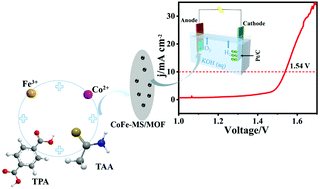Bimetallic sulfide particles incorporated in Fe/Co-based metal–organic framework ultrathin nanosheets toward boosted electrocatalysis of the oxygen evolution reaction†
Abstract
The development of inexpensive, high-performance, and long-lasting electrocatalysts toward the oxygen evolution reaction (OER) has been proved to be crucial to enhance the efficiency of water splitting to obtain clean and sustainable energy. Herein, Fe/Co-based metal–organic framework (MOF) ultrathin nanosheets doped with (Fe)-Co3S4 metal sulfide (MS) particles (CoFe-MS/MOF) are reported as superior electrocatalysts for the OER. CoFe-MS/MOFs exhibit an outstanding OER performance with a small overpotential of 261 mV and a low Tafel slope of 60.3 mV dec−1 at a current density of 10 mA cm−2 while showing high durability in an alkaline medium. The existence of metal sulfide particles plays a pivotal part in promoting the charge transfer capacity as well as the formation of ultrathin MOF nanosheets. More significantly, they can also modulate the adsorption energy of oxygenated intermediates, thereby significantly enhancing the inherent electrocatalytic activity. This work provides guidance for rationally designing and synthesizing inexpensive and highly active bimetallic sulfide doped MOF electrocatalysts in the electrochemical energy field.



 Please wait while we load your content...
Please wait while we load your content...